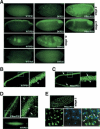Identification of phosphatases for Smad in the BMP/DPP pathway
- PMID: 16510868
- PMCID: PMC1413280
- DOI: 10.1101/gad.1384706
Identification of phosphatases for Smad in the BMP/DPP pathway
Abstract
Phosphorylation of the SSXS motif of Smads is critical in activating the transforming growth factor beta (TGF-beta) and bone morphogenetic protein (BMP) pathways. However, the phosphatase(s) involved in dephosphorylating and hence inactivating Smads remained elusive. Through RNA interference (RNAi)-based screening of serine/threonine phosphatases in Drosophila S2 cells, we identified pyruvate dehydrogenase phosphatase (PDP) to be required for dephosphorylation of Mothers against Decapentaplegic (MAD), a Drosophila Smad. Biochemical and genetic evidence suggest that PDP directly dephosphorylates MAD and inhibits signal transduction of Decapentaplegic (DPP). We show that the mammalian PDPs are important in dephosphorylation of BMP-activated Smad1 but not TGF-beta-activated Smad2 or Smad3. Thus, PDPs specifically inactivate Smads in the BMP/DPP pathway.
Figures





Similar articles
-
TGF-beta family signal transduction in Drosophila development: from Mad to Smads.Dev Biol. 1999 Jun 15;210(2):251-68. doi: 10.1006/dbio.1999.9282. Dev Biol. 1999. PMID: 10357889 Review.
-
Endofin acts as a Smad anchor for receptor activation in BMP signaling.J Cell Sci. 2007 Apr 1;120(Pt 7):1216-24. doi: 10.1242/jcs.03400. Epub 2007 Mar 13. J Cell Sci. 2007. PMID: 17356069
-
PP2A regulates BMP signalling by interacting with BMP receptor complexes and by dephosphorylating both the C-terminus and the linker region of Smad1.J Cell Sci. 2009 Apr 15;122(Pt 8):1248-57. doi: 10.1242/jcs.039552. J Cell Sci. 2009. PMID: 19339557
-
Ter94/VCP is a novel component involved in BMP signaling.PLoS One. 2014 Dec 3;9(12):e114475. doi: 10.1371/journal.pone.0114475. eCollection 2014. PLoS One. 2014. PMID: 25469707 Free PMC article.
-
Opposing effects of Wnt and MAPK on BMP/Smad signal duration.Dev Cell. 2007 Dec;13(6):755-6. doi: 10.1016/j.devcel.2007.11.006. Dev Cell. 2007. PMID: 18061555 Review.
Cited by
-
Drosophila Dullard functions as a Mad phosphatase to terminate BMP signaling.Sci Rep. 2016 Aug 31;6:32269. doi: 10.1038/srep32269. Sci Rep. 2016. PMID: 27578171 Free PMC article.
-
Axin2 controls bone remodeling through the beta-catenin-BMP signaling pathway in adult mice.J Cell Sci. 2009 Oct 1;122(Pt 19):3566-78. doi: 10.1242/jcs.051904. Epub 2009 Sep 8. J Cell Sci. 2009. PMID: 19737815 Free PMC article.
-
Regulation of Smad activities.Biochim Biophys Acta. 2006 Nov-Dec;1759(11-12):503-13. doi: 10.1016/j.bbaexp.2006.11.001. Epub 2006 Nov 15. Biochim Biophys Acta. 2006. PMID: 17182123 Free PMC article. Review.
-
Targeting TGF-β signaling in cancer.Expert Opin Ther Targets. 2013 Jul;17(7):743-60. doi: 10.1517/14728222.2013.782287. Epub 2013 May 7. Expert Opin Ther Targets. 2013. PMID: 23651053 Free PMC article. Review.
-
Fez function is required to maintain the size of the animal plate in the sea urchin embryo.Development. 2011 Oct;138(19):4233-43. doi: 10.1242/dev.069856. Epub 2011 Aug 18. Development. 2011. PMID: 21852402 Free PMC article.
References
-
- Abdollah S., Macias-Silva M., Tsukazaki T., Hayashi H., Attisano L., Wrana J.L. TβRI phosphorylation of Smad2 on Ser465 and Ser467 is required for Smad2–Smad4 complex formation and signaling. J. Biol. Chem. 1997;272:27678–27685. - PubMed
-
- Attisano L., Wrana J.L. Signal transduction by the TGF-β superfamily. Science. 2002;296:1646–1647. - PubMed
-
- Barford D., Das A.K., Egloff M.P. The structure and mechanism of protein phosphatases: Insights into catalysis and regulation. Annu. Rev. Biophys. Biomol. Struct. 1998;27:133–164. - PubMed
-
- Chen X., Rubock M.J., Whitman M. A transcriptional partner of MAD proteins in TGF-β signalling. Nature. 1996;383:691–696. - PubMed
Publication types
MeSH terms
Substances
LinkOut - more resources
Full Text Sources
Other Literature Sources
Molecular Biology Databases
